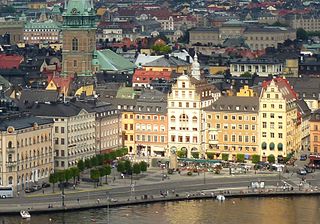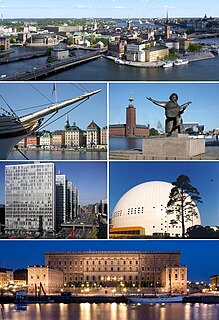
Trångsund is a short, narrow street in Gamla stan, the old town of Stockholm, Sweden. Stretching from Stortorget in front of Storkyrkan to Storkyrkobrinken, it is intercepted by Ankargränd and Spektens Gränd and forms a parallel street to Prästgatan and Källargränd.
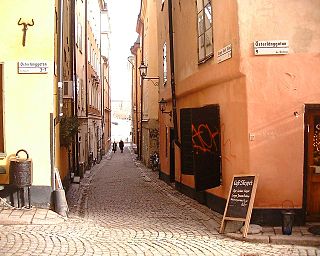
Skeppar Karls Gränd is an alley in Gamla stan, the old town of Stockholm, Sweden. Stretching from Skeppsbron to Österlånggatan, it forms a parallel street to Telegrafgränd and Bredgränd.

Bredgränd is an alley in Gamla stan, the old town of Stockholm, Sweden. Stretching from Skeppsbron to Österlånggatan, it forms a parallel street to Skeppar Karls Gränd and Kråkgränd.

Mårten Trotzigs gränd is an alley in Gamla stan, the old town of Stockholm, Sweden. Leading from Västerlånggatan and Järntorget up to Prästgatan and Tyska Stallplan, the width of its 36 steps tapers down to a mere 90 centimetres (35 in), making the alley the narrowest street in Stockholm.
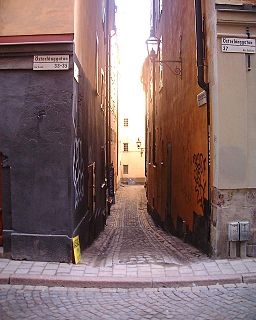
Lilla Hoparegränd is an alley in Gamla stan, the old town of Stockholm, Sweden. Passing between Skeppsbron and Österlånggatan, it forms a parallel street to Ferkens Gränd, Gaffelgränd, Pelikansgränd, and Johannesgränd.
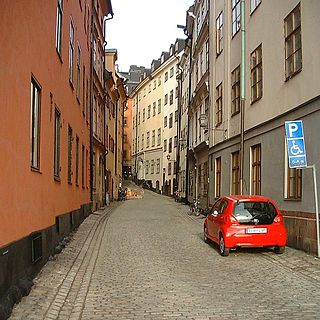
Drakens Gränd is an alley in Gamla stan, the old town of Stockholm, Sweden. Stretching from Skeppsbron to Österlånggatan, it forms a parallel street to Stora Hoparegränd and Ferkens Gränd.

Johannesgränd is an alley in Gamla stan, the old town of Stockholm, Sweden, connecting Skeppsbron to Österlånggatan.

Yxsmedsgränd is an alley in Gamla stan, the old town in central Stockholm, Sweden.

Funckens Gränd is an alley in Gamla stan, the old town in central Stockholm, Sweden. Leading south from the street Västerlånggatan to the square Kornhamnstorg, it forms a parallel street to Torgdragargränd and Triewaldsgränd.

Didrik Ficks Gränd is an alley in Gamla stan, the old town of Stockholm, Sweden. Stretching from Västerlånggatan to Stora Nygatan, it forms a parallel street to Sven Vintappares Gränd and Yxsmedsgränd while passing on the south side of the small square Sven Vintappares Torg.
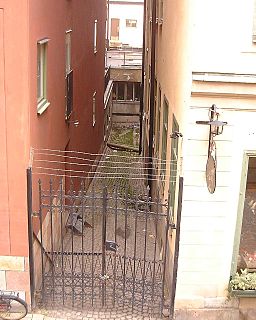
Fru Gunillas Gränd is a historical alley in Gamla stan, the old town in central Stockholm, Sweden, once connecting Skeppsbron to Österlånggatan between Johannesgränd and Packhusgränd.

Klockgjutargränd is a small alley in Gamla stan, the old town in central Stockholm, Sweden. Passing under a low vault, it connects the street Västerlånggatan to the public square and courtyard Brantingtorget, forming a parallel street to Salviigränd and Kolmätargränd.
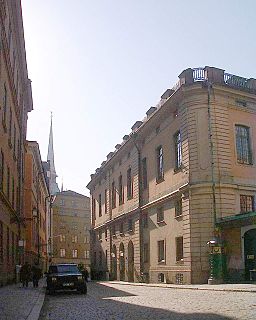
Källargränd is an alley in Gamla stan, the old town in central Stockholm, Sweden, connecting Slottsbacken, the slope south of the Royal Palace, to the square Stortorget. It forms a parallel street to Trångsund and is intercepted by Trädgårdsgatan.

Schönfeldts Gränd is an alley in Gamla stan, the old town in central Stockholm, Sweden. Stretching south-west from Stora Nygatan to Mälartorget it is crossed by Lilla Nygatan and Munkbrogatan, and forms a parallel street to Kåkbrinken and Lejonstedts Gränd.
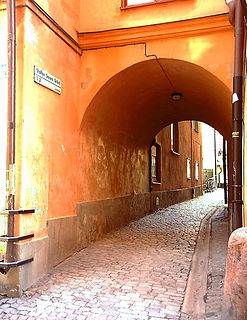
Staffan Sasses Gränd is a blind alley in Gamla stan, the old town in central Stockholm, Sweden. Stretching north from Köpmangatan, it forms a parallel street to Bollhusgränd and Peder Fredags Gränd.

Stora Gråmunkegränd is an alley in Gamla stan, the old town in central Stockholm, Sweden. Stretching west from Västerlånggatan down to Munkbron and Munkbroleden, it is crossed by Stora Nygatan, and forms a parallel street to Storkyrkobrinken and Helga Lekamens Gränd.

Sven Vintappares Gränd is a small alley in Gamla stan, the old town of Stockholm, Sweden. Stretching from Västerlånggatan to Stora Nygatan, it forms a parallel street to Överskärargränd and Didrik Ficks Gränd, while passing on the north side of the small square Sven Vintappares Torg.
Triewaldsgränd is an alley in Gamla stan, the old town in central Stockholm, Sweden. Stretching south from the square Järntorget to Kornhamnstorg and Munkbroleden, it forms a parallel street to Funckens Gränd and Järntorgsgatan.
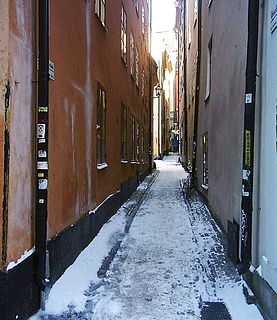
Överskärargränd is an alley in Gamla stan, the old town in central Stockholm, Sweden. Stretching from Västerlånggatan to Stora Nygatan passing on the south side of Gåstorget, it forms a parallel street to Gåsgränd and Sven Vintappares Gränd.
Fisketorget or Fiskaretorget is a historical public square in Gamla stan, the old town in central Stockholm, Sweden. It was once located on the east shore of the island Stadsholmen, between the present streets Österlånggatan and Skeppsbron, and between the present alleys Nygränd and Brunnsgränd.


